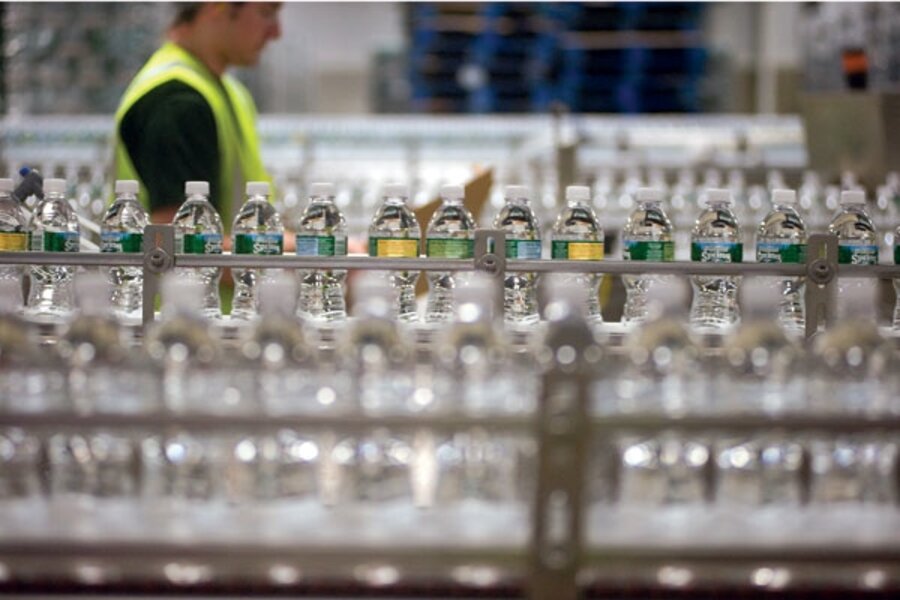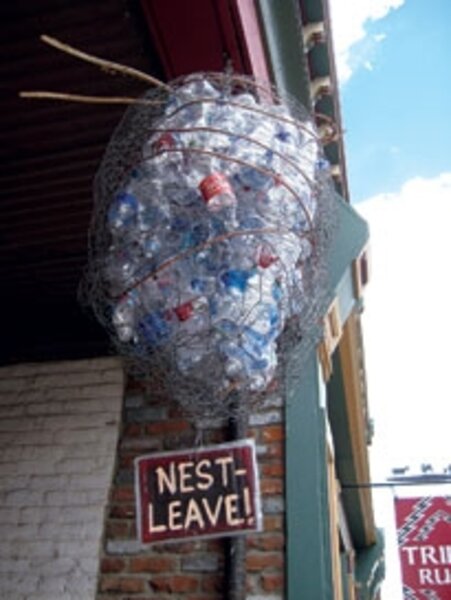Pressure builds over bottled water
Loading...
| SALIDA, Colo.
In many ways Salida, Colo., typifies the 21st-century Rocky Mountain town. Originally founded along a railroad line in the late 1800s, it’s now geared primarily toward tourism.
Among the red brick buildings of the historic center where ranchers, miners, and railroad workers once held sway, tourists now move between coffee shops, galleries, and outfitters. During warmer months, kayakers “surf” a man-made wave in the fast-flowing Arkansas River, which marks the edge of the downtown area.
For the better part of this year, Salida – population 5,400 – has also been the setting for a 21st century kind of battle – over water.
Here and there in windows and entryways are signs reading “Stop Nestlé” or “Nest-Leave.” They refer to a proposed project by Nestlé Waters North America, which hopes to pump water from a spring a half-hour north of here and sell it under its Arrowhead label.
Citing myriad concerns, a group of residents has objected vigorously. They worry about impacts to the watershed and to nearby wetlands. They say that climate change, predicted to further dry Colorado and the Southwest, warrants a precautionary approach to all things water-related. And, pointing to fights other communities have had with the company, they say they simply don’t want Nestlé as a neighbor.
Nestlé counters that these concerns are overblown. The company says: The amount of water it plans to withdraw is negligible; the project will bring many benefits – economic and otherwise – to the community; and the company, the largest water bottler in North America, is an upstanding corporate citizen.
In mid-August, after months of public hearings and expert testimony, the county finally gave approval to the project – but attached 44 conditions.
“We still feel that the decision to grant them the permit is not a wise decision,” says John Graham, president of the Chaffee Citizens for Sustainability (CCFS), which has led the opposition against the project. The group is weighing what to do next.
Nestlé is satisfied with the outcome, says Bruce Lauerman, a natural resources manager for the company. “We can, and will, comply with all the conditions.”
So what’s the big deal?
The springs in question are to the middle and east of the Upper Arkansas Valley. Boulders lie strewn about, carried to their current positions more than 10,000 years ago when ice dams blocking the Arkansas River breached, inundating the valley. Water from the spring now collects in clear pools. Trout flit beneath the silvery surface. Rafters occasionally float past on the turbid river, which marks the southern boundary of the property on which the springs are located.
Water seems to abound. Nestlé plans to pump 200 acre-feet per year, or enough water to flood 200 acres with one foot of water. That’s 1 to 2 percent of the aquifer recharge coming from a 50,000-acre watershed to the east, says Mr. Lauerman. “This is a safe, sustainable way to withdraw water. End of story.”
But many say the greater story – about a growing world population of more than 6.5 billion faced with a limited supply of fresh water – is, in fact, just beginning.
Experts not directly involved in the Chaffee County situation point to it as evidence of rising sensitivity to water issues everywhere. They cite a growing number of disagreements between communities and bottled-water firms around the US – in Maine, California, Florida, and Michigan, among other places – as evidence.
“There is a growing interest in water as a whole [and] growing scarcity in the Western United States,” says Peter Gleick, president of the Pacific Institute in Oakland, Calif., a nonprofit that does research and policy analysis in the areas of environment and sustainable development. “And when people pay more attention, it sort of makes it harder to do the things [bottled water companies] used to do without any opposition.”
These companies have now become the focus of campaigns against bottled water in general. Organizations like Corporate Accountability International and the Environmental Working Group rail against bottled water for a number of reasons, the environmental impact of plastics among them. (Lauerman points to Nestlé’s new ecoshape bottles, which, he says, use 30 percent less plastic than most.) The groups also argue that consumption of bottled water – paying for something that’s already cheaply available – leads to neglect of municipal water infrastructure, to everyone’s detriment.
The US Conference of Mayors has urged cities to stop buying water and has called for an investigation into how much the industry costs taxpayers. (By one estimate, 40 percent of bottled water comes from municipal sources, not springs.)
All of this opposition has had some impact. San Francisco and Seattle, among other cities, have prohibited city offices from buying bottled water. Maine is now considering a penny-a-gallon bottled water tax. High-end restaurants in Los Angeles and New York have stopped serving bottled water, a once-easy moneymaker, to avoid “ungreen” reputations. And in August, Bundanoon, Australia – population 2,500 – became the first town in the world to prohibit the sale of bottled water. A proposed bottled-water operation prompted the all-out ban.
Deserved or not, Nestlé, whose brands focus primarily on spring water and not the easier-to-procure filtered water from other sources, has become a favorite target of the anti-bottled-water movement. There’s a website called Stop Nestle Waters.org, and a documentary called “For the Love of Water,” or FLOW, casts the company in an unfavorable light. Nestlé has responded to FLOW with its own video .
Lauerman attributes anti-Nestlé sentiment and court battles to its being the largest producer of foodstuffs in the world and the largest bottled-water company in North America. Big companies make big targets, he says. As for the resistance in Chaffee County, he calls it “emotional” and not based on fact.
Others have a different take.
“Citizens are better off rejecting the zoning right at the beginning rather than getting into long, expensive litigation,” says Jim Olson, an environmental attorney in Traverse City, Mich., who has fought Nestlé for more than nine years.
“The lesson learned is: Don’t let it start,” he says. Indeed, worried by the prospect of facing a deep-pocketed corporation in court, one of the conditions that Chaffee County mandated was that Nestlé establish a reimbursement fund to pay for any future litigation.
And there’s another detail in the agreement that strikes many as notable. In drought-prone Colorado, law dictates that anyone applying for a water permit must present an “augmentation plan.”
Nestlé, for example, will replace water it pumps with water leased from Aurora, a city 100 miles to the northeast. The city will redeposit an amount of water equal to what Nestlé withdraws into the upper Arkansas River. Chaffee County mandated that replacement water must come from other counties, or the water-permitting process reopens.
The county has guaranteed itself a net-zero water loss.
These laws can seem Byzantine, even anachronistic, to the outsider. Only earlier this year, for example, did Colorado legalize rainwater harvesting. Before that, it was technically illegal to catch water falling off one’s own roof.
But the assumption underlying these laws – that water is in limited supply – is the correct one, says Robert Glennon, author of “Unquenchable: America’s Water Crisis and What to Do About It.” Other states often allow “a limitless number of straws in the glass,” he says.
But in Colorado, if you can’t replace it, you can’t take it. “That’s exactly what I think we should do,” he says.
Editor’s note: For more articles about the environment, see the Monitor’s main environment page, which offers information on many environment topics. Also, check out our Bright Green blog archive and our RSS feed.






